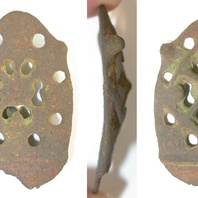
Viking Objects
Copper-Alloy Strap-End (DENO-083C15)
This copper-alloy strap-end, classified as Thomas Class E, is decorated with a central openwork lozenge with two perforations within each quarter surrounded by eight circular perforations. Strap ends came in various styles and were fairly common throughout the Viking world. They were used to decorate the ends of belts and to stop them getting damaged.
Read More
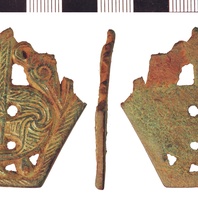
Viking Objects
Copper-Alloy Mount Fragment (NLM-92AFEC)
This copper-alloy mount fragment is likely from a horse harness and is decorated with closely-spaced diagonal hatching framing for a zoomorphic openwork design of four battling beasts around a central roundel. The front of the mount contains extensive traces of gilding. The object is considered an example of Irish or Hiberno-Norse metalwork and thus is associated with Viking activities around the Irish Sea region.
Read More
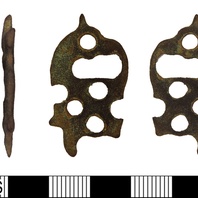
Viking Objects
Urnes-Style Strap-End (LEIC-B46A41)
This fragmentary copper-alloy strap-end is decorated with openwork zoomorphic design in the Urnes style. It has been classified as a Thomas Class G strap-end.
Read More
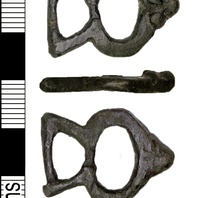
Viking Objects
Buckle Frame (DENO-98937A)
This copper-alloy buckle frame has a pin rest of zoomorphic form with two widely spaced rounded ears and a rounded snout. It has been classified as a Thomas Class B Type 4 buckle and the decoration is classed as Borre style.
Read More
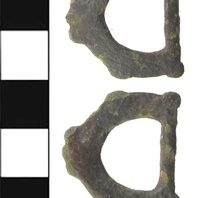
Viking Objects
Ringerike Buckle (SWYOR-22FFC7)
This cast copper-alloy buckle has some elements of the Ringerike style decorating a broad, flat frame and a narrowed strap bar.
Read More
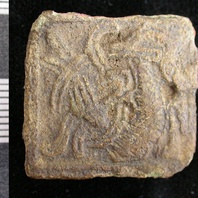
Viking Objects
Square Mammen Style Brooch ( LEIC-6AF276)
This small brooch features a bird depicted in the Mammen style. This style of brooch appears to have been produced in the Danelaw but, generally, Mammen-style decoration is rare in Britain. This brooch from Linwood, Lincolnshire, is paralleled by examples from West Stow Heath, Suffolk, and Bergh Apton, Norfolk, but further examples from Cambridgeshire and East Anglia were found in 2015 and 2016. It is a type which has Carolingian-inspired shapes and Scandinavian decoration. Such brooches were an accessory for women who wore Scandinavian dress. For more information on Scandinavian jewellery in England check out our blog: Brooches, Pendants and Pins: Scandinavian Dress Accessories in England.
Read More
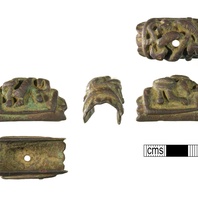
Viking Objects
Decorative Sword Mount (WMID-2FF927)
A cast copper alloy sword mount with English Urnes style decoration which could have been used on the sword pommel. Pommel mounts developed over time from simple rounded or triangular pieces of metal to more stylized multi-pronged designs. They could be decorated with various inlays or gilding. Pommel mounts are often the only indicators for attributing swords to typologies and, therefore, dating them.
Read More
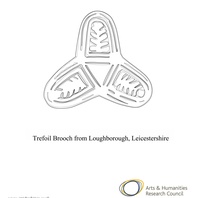
Viking Designs
Drawing of a Trefoil Brooch
A drwaing of a copper alloy trefoil brooch of a type that would have been common in the Danelaw. Trefoil brooches were characteristically Scandinavian women’s wear. However, many examples found in the East Midlands were probably made in the Danelaw, and may have been copies of Scandinavian styles, instead of being imported from Scandinavia. Scandinavian brooches came in a variety of sizes and shapes which included disc, trefoil, lozenge, equal-armed, and oval shapes. The different brooch types served a variety of functions in Scandinavian female dress with oval brooches typically being used as shoulder clasps for apron-type dresses and the rest being used to secure an outer garment to an inner shift. Anglo-Saxon brooches do not match this diversity of form with large disc brooches being typical of ninth century dress styles with smaller ones becoming more popular in the later ninth and tenth centuries. However, since disc brooches were used by both Anglo-Saxon and Scandinavian women they are distinguished by their morphology. Scandinavian brooches were typically domed with a hollow back while Anglo-Saxon brooches were usually flat. Moreover, Anglo-Saxon brooches were worn singly without accompanying accessories.
Read More
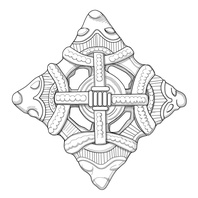
Viking Designs
Drawing of a Lozenge Brooch
Drawing of a copper alloy lozenge brooch in the Borre style. This type of brooch was common throughout the Danelaw in the Viking Age and was used as an accessory by women who wore Scandinavian dress. Scandinavian brooches came in a variety of sizes and shapes which included disc, trefoil, lozenge, equal-armed, and oval shapes. The different brooch types served a variety of functions in Scandinavian female dress with oval brooches typically being used as shoulder clasps for apron-type dresses and the rest being used to secure an outer garment to an inner shift. Anglo-Saxon brooches do not match this diversity of form with large disc brooches being typical of ninth century dress styles with smaller ones becoming more popular in the later ninth and tenth centuries. However, since disc brooches were used by both Anglo-Saxon and Scandinavian women they are distinguished by their morphology. Scandinavian brooches were typically domed with a hollow back while Anglo-Saxon brooches were usually flat. Moreover, Anglo-Saxon brooches were worn singly without accompanying accessories.
Read More
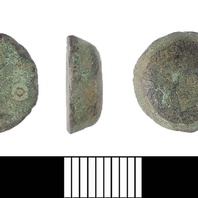
Viking Objects
Circular Weight (LIN-F9FD63)
This copper-alloy weight is decorated with a central punched ring-and-dot motif surrounded by a band of five further ring-and-dot motifs. Weights are an important form of evidence for Viking Age commerce and the use of standards across the different economic systems within which Vikings were integrated. Many of the weights discovered, particularly ones in Ireland and those of Arabic type, suggest that a standardized system of weights existed in some areas. These standard weights, alongside standard values of silver, are what allowed the bullion economy of Viking-occupied areas to function. A bullion economy was a barter economy that relied on the exchange of set amounts of precious metal in various forms, such as arm-rings or coins, for tradeable goods, such as food or textiles. Each merchant would have brought their own set of weights and scales to a transaction to make sure that the trade was conducted fairly.
Read More
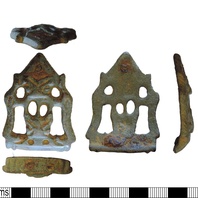
Viking Objects
Stirrup-Strap Mount (PUBLIC-ED7865)
This example of an Anglo-Scandinavian copper-alloy stirrup-strap mount is classed as a Williams Class B Type 2 and is decorated with openwork zoomorphic designs.
